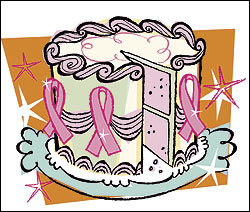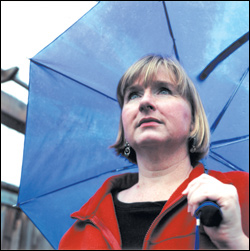First, let’s talk about cake. Then let’s talk about why you shouldn’t “indulge for the cure.”
Twelve Seattle-area restaurants have joined in an event sponsored by Athena Partners, best known for its bottled water, to offer pink desserts during October, which—in case you missed the countless pink ribbons suddenly blooming everywhere— is Breast Cancer Awareness Month.
Chefs at the restaurants created special pink desserts to mark the occasion. Examples include “Pink Cloud” (white chocolate angel-food cake with Chambord sabayon) at Ray’s Boathouse; “Tickled Pink” (a raspberry cupcake with pink mascarpone frosting, accompanied by a strawberry ice-cream truffle and pink-ribbon butter cookie) at the Yarrow Bay Grill; and “Kick It” (bittersweet chocolate pound cake and chocolate ganache wrapped in a pink-and-white “tootsie roll”) at Earth & Ocean. If you order one of these desserts, the restaurant will donate the net profits to Athena, which in turn will give the money to organizations that do research on breast and gynecological cancers.
I work as a freelance Web writer for the Seattle Cancer Care Alliance, where I’m also a patient, receiving ongoing treatment for metastatic breast cancer. I recently sampled the pink dessert at the Dahlia Lounge in order to write about it for the SCCA site—and it was delicious. The Dahlia’s pink dessert is a warm brown-butter almond cake, with fresh figs and a scoop of prosecco ice cream, topped with the ubiquitous ribbon, in this case made of pale pink meringue. I enjoyed every bite, except for the ribbon, which I left on the side of my plate. The dessert costs $8.
So let’s do the math. You order the dessert for $8, plus a cup of coffee for, say, $2. Add in tax and tip, and the bill comes to about $13. Of that, the restaurant gives Athena the net profit, generally between $3 and $4, according to Trish May, founder of Athena Partners and a breast cancer survivor herself. The Dahlia Lounge had sold 34 desserts in five days. So, say they sell 204 in the month; that’s only a donation of about $800. Pocket change. One small research project costs hundreds of thousands of dollars a year, if not more.
There’s a simpler solution: Skip dessert and send $8, or the whole $13, directly to your favorite hospital or research center. I don’t like to criticize local restaurants that step up when asked to raise money for cancer research, but I think the “pink dessert” campaign is misguided.
Then there’s the issue of overeating. The campaign tag line is “indulge for the cause,” which, in my view, encourages women (and men, for that matter) to feel OK about overeating because it’s for a good cause. How many Seattle women realize that being overweight or obese may double their risk of getting breast cancer? That’s according to SCCA’s Dr. Julie Gralow, a co-author of Breast Fitness. For women who are breast cancer survivors, being overweight doubles the chances that the cancer will return.
I’m willing to go easy on nonprofits like Athena, which exists solely to raise money for cancer research and awareness, but the amount raised this way is surprisingly small. Athena sold 1 million bottles of water in its first year in existence (with the motto “Every bottle brings us closer to a cure”), but donated only $30,000 to cancer research. And that’s with the founder, May, paying most of the start-up costs out of her own pocket.
Where pink marketing really runs wild is in the for-profit sector. Retailers offer pink-themed merchandise, then donate only a tiny share of the profits to cancer research. I’m tripping over these products everywhere I go this month. At the pet store, a pink dog collar printed with pink ribbons sells for $9.99; the tag says 30 cents (30 cents!) from the sale of this product will be donated to the Susan G. Komen Breast Cancer Foundation, the 800-pound gorilla of cause marketing.
But wait, there’s more! At the tea shop, a pink tin of candy. At the supermarket, pink M&Ms—buy the M&Ms for $2.99, and Komen gets 50 cents. (Three dollars for an 8-ounce package amounts to four times the usual price, based on volume.) Other recent pink products: scarves, clothing, and nail polish. Nail polish? All of this just encourages us to indulge in retail therapy while trivializing a very serious disease. This is not about raising money for cancer research; this is about companies selling you stuff you don’t need, just to make a profit. Don’t fall for it.






